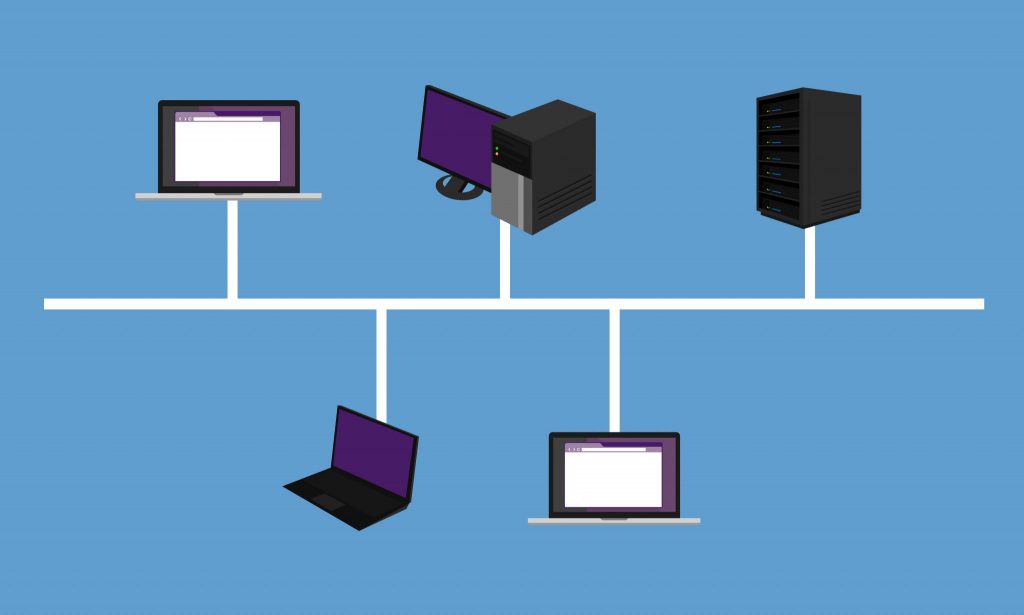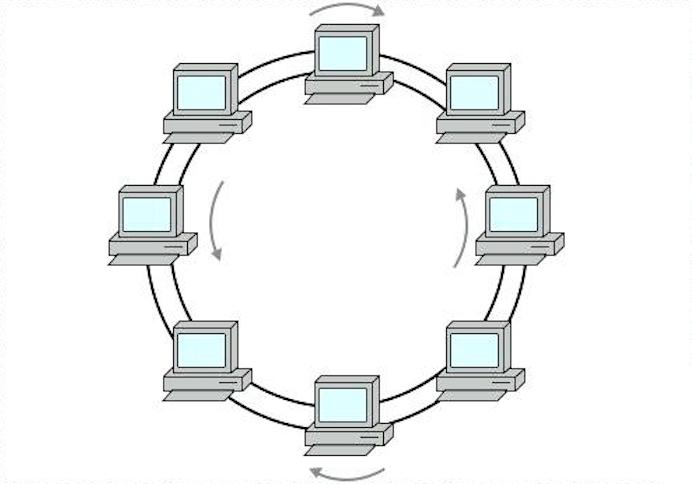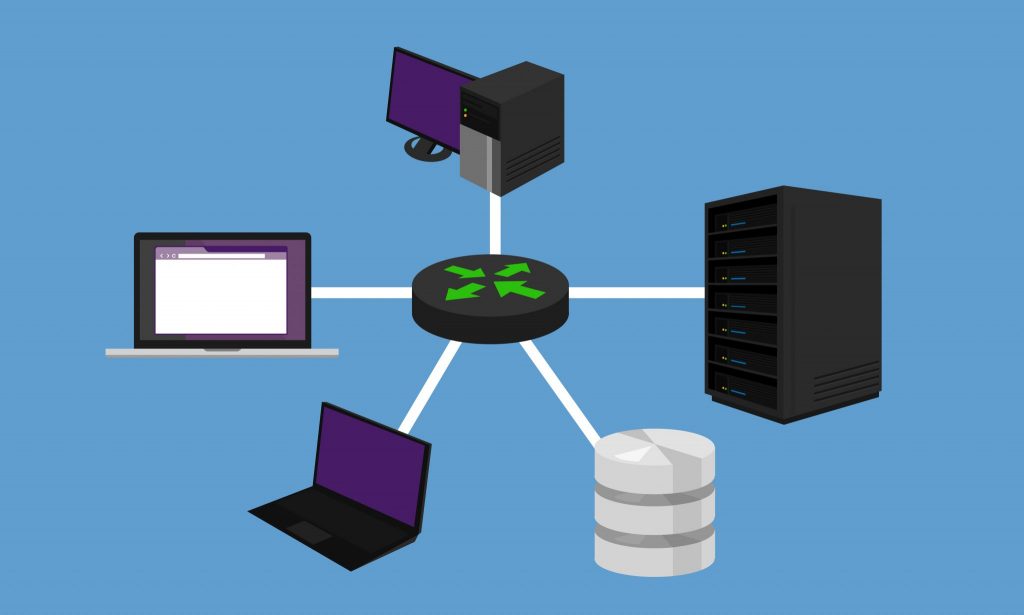In this tech-driven world, networking plays a crucial role in every individual’s and every organization’s day-to-day activities. But there has to be some specific models or guidelines that must be followed to connect one device to another. This logical or physical layout or configuration of a network is known as a network topology, and if you are an IT pro, here’s what you need to know.
A network topology is a substantial arrangement of a network in which all the nodes are connected with each other using network links or connecting lines. Apart from just describing how the nodes are interconnected, network topology also explains how the data is transferred in a network.
A logical network topology is a high-level representation of how two or more nodes are connected. A logical network topology describes or explains how signals act on a network and how the data is transmitted from one node to another at a very high level. On the other hand, a physical topology describes how nodes are physically connected to each other. The physical connection can be made using wires, wireless connectivity, networking components, and more.
Importance of network topology
- Plays a significant role in the functioning of networks.
- Helps us better understand the networking concepts.
- Plays a crucial role in performance.
- Helps reduce the operational and maintenance costs such as cabling costs.
- A network topology is a factor in determining the media type to be used to cable a network.
- Error or fault detection is made easy using network topologies.
- Effective utilization of resources and networking components.
Network topology classification
Both physical and logical network topologies can be broadly classified into five basic models.
Bus topology
Bus topology refers to a network setup where nodes or devices are interconnected using a single cable. It is because of this setup why bus topology is often referred to as line topology or backbone. Depending on the nodes or devices that need to be connected, a coaxial cable or an RJ45 cable is typically used to connect the devices.

Bus topology usually consists of two ends and signals travel from one end to another. Bus topology is unidirectional and data is transferred from one end to another in a single direction.
Advantages
- Cost-effective.
- Less cable required to connect the nodes.
- Very easy to understand.
- Provides an easy feasibility to extend or to reduce a network.
- Ideal for small network setups.
Disadvantages
- Ideal only for small network setups.
- If the backbone (primary) cable fails, the entire network fails.
- Unidirectional.
- Transmission speeds are drastically reduced with the increased number of nodes.
Ring topology
As the name suggests, a ring network topology forms a ring as each node or computer in a network are connected to each other in a circular manner. Every node or device in a ring topology will have exactly two neighbors and accordingly, the last node in the network will be connected to the first node.

In a ring topology, all devices are connected in a closed loop configuration and one node in the network acts as a monitor, which essentially takes care of the configuration. In a ring topology, all the data packets are transmitted from one node to another in a circular manner and, therefore, for a data packet to reach one point to another it has to traverse through all the intermediate nodes. For large networks with more nodes connected in a ring, repeaters can be used to prevent data loss in these data transmissions.
Dual ring topology
The data transmission is usually unidirectional in a ring network topology but it can be configured to support bidirectional transmissions as well. This is known as dual ring topology and can be configured by having two connections between each network node.

In a dual ring topology, two rings are formed between the nodes. One ring supports data flow in one direction, while the other ring supports the data flow in another direction, making it unidirectional. Another important advantage of a dual ring topology is that one ring out of the two can act as a backup for another in case of any failures, ensuring the network continuity.
Advantages
- Performs better than bus topology under heavy network loads.
- Point-to-point connectivity of the nodes makes it easy to identify and detect misconfigurations or faults.
- Orderly network flow.
- Cost effective to implement.
Disadvantages
- One malfunctioning node can collapse the whole network.
- Transmission line failure can take down the whole network.
- Communication delay is proportional to the number of nodes in a ring.
- Bandwidth is shared among all the devices in a network.
- Reconfiguring, adding, or removing nodes requires the network to shut down.
Star topology

In a star topology, every node in the network is connected to a central computer or a node, which takes care of the network. Every device in the network has a direct connection to the central node and every node is indirectly connected to other nodes using the central node.
All the data in a star topology flow through the central hub before it reaches its destination. The central hub manages and controls all data transfers and connectivity in a star topology. The central hub also acts as a repeater to make sure there is zero or minimal data loss during the transmissions. A star topology can be configured using a twisted pair, coaxial cable, or an optical fiber.
Advantages
- Failure of one node will not affect the entire network.
- Devices can be added, removed, reconfigured, or modified without disturbing the network.
- Less cabling is needed to configure star topology.
- Easy to set up and modify.
- Easy to troubleshoot.
Disadvantages
- The entire network is dependent on the central hub: If the hub fails, then the whole network will be down.
- Expensive to install and use.
- Performance is solely based on the central hub’s configuration, power, and efficiency.
Mesh topology
Mesh topology is a widely used network model that has a point-to-point connection between each node in the network. Every node or a device in a mesh network connects to other nodes directly and in a non-hierarchical manner. In a mesh network, the network isn’t dependent on a single machine like the star topology and every node plays an active role in the relay of information.
Data transmission in a mesh topology is based on two important techniques.
1) Routing
2) Flooding
Routing
Every node in a mesh network can have a routing logic and transmission of data or information happens through that routing logic. This routing logic can be used to find the shortest distance to send some information from sender to receiver or the logic can be used to avoid using broken lines for data transmission.
Flooding
In the case of flooding, the same data is transmitted to each node in the network. Therefore, no routing logic is required in case of flooding mesh networks. Loss of data is highly unlikely as every node will have the same data with them. This makes it robust and fault-tolerant. However, this also increases the load on the network.
Advantages
- Fully connected.
- Robust.
- Provides security and privacy.
- Any node failure won’t affect the network.
- Less load and collisions to dedicated lines.
- Isolation and fault-detection are easy.
Disadvantages
- Cost of implementing and cost of cabling is high.
- Installation and reconfiguring is a typical task.
- Complex to understand.
Hybrid topology
When a network topology is formed by integrating two or more topologies together, this results in a hybrid topology. Hybrid topologies can be configured as per the company’s requirement. When configured properly, hybrid topologies can provide the best of all the network topologies. Hybrid topologies are easy to scale and expand. However, they might need higher costs and more operational efforts to configure and maintain.

Tree topology
A tree network topology is one of the most common examples of a hybrid topology. It is also referred as a star-bus network topology in which star networks are interconnected with one another using a bus network. In a tree topology, nodes are connected with one another in a hierarchical manner and are therefore also known as hierarchal topology.
Advantages
- Flexibility.
- Scalable; Easy to add or remove nodes.
- Suitable for large networks.
- Easy to manage.
Disadvantages
- Costly.
- Complex to design and maintain.
Choosing the right network topology depends on multiple factors such as the number of nodes to be involved in the network, geographical distance between the nodes, finances, maintenance, operational flexibility, and more.
Every topology we discussed above has its own advantages and disadvantages. Therefore, the key to build and configure the right networking model is subjective. For any company, it is very important to first gather all the requirements and needs before adopting any particular network topology.
Featured image: Shutterstock




Was this article written in 1999?
No one in their right mind would use a bus or ring topology today.
Hello Peter,
This article is to give readers an idea about how each of these network topology works. I haven’t mentioned about using any particular topology.
Just to add further, a lot of the production line units in factories and industries still have bus topology in use.
Thanks.
Nevertheless, many enterprises lack the efficiency and resources required for an efficient operation in this age of IoT and hence special services must be provided by the MSPs to make it easy for the enterprises to take full benefits of IoT.
I was with a large enterprise media company that implemented a ring topology 4 years ago…
which type of data is sent through the ring topology?
Why do we think the Ring topology is named so?